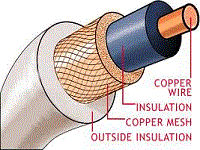Ohmmeter Ranges
Ohmmeter Ranges
The amount of circuit resistance to be measured may vary over a wide range. In some cases it may be only a few ohms, and in others it may be as great as 1,000,000 ohms (1 megohm). To enable the meter to indicate any value being measured, with the least error, scale multiplication features are used in most ohmmeter ranges .
For example, a typical meter will have four test lead jacks-COMMON, R ´ 1, R ´ 10, and R ´ 100. The jack marked COMMON is connected internally through the battery to one side of the moving coil of the ohmmeter. The jacks marked R ´ 1, R ´ 10, and R ´ 100 are connected to three different size resistors located within the ohmmeter. This is shown in the figure below.

An ohmmeter with multiplication jacks.
Some ohmmeters are equipped with a selector switch for selecting the multiplication scale desired, so only two test lead jacks are necessary. Other meters have a separate jack for each range, as shown in the figure above.
The range to be used in measuring any particular unknown resistance (Rx in the figure above) depends on the approximate value of the unknown resistance. For instance, assume the ohmmeter in the figure above is calibrated in divisions from 0 to 1,000. If Rx is greater than 1,000 ohms, and the R x 1 range is being used, the ohmmeter cannot measure it.
This occurs because the combined series resistance of resistor R ´ 1 and Rx is too great to allow sufficient battery current to flow to deflect the pointer away from infinity (¥). (Infinity is a quantity larger than the largest quantity you can measure.) The test lead would have to be plugged into the next range, R ´ 10. With this done, assume the pointer deflects to indicate 375 ohms. This would indicate that Rx has 375 ohms ´ 10, or 3,750 ohms resistance.
The change of range caused the deflection because resistor R ´ 10 has about 1/10 the resistance of resistor R ´ 1. Thus, selecting the smaller series resistance permitted a battery current of sufficient amount to cause a useful pointer deflection. If the R ´ 100 range were used to measure the same 3,750-ohm resistor, the pointer would deflect still further, to the 37.5-ohm position. This increased deflection would occur because resistor R ´ 100 has about 1/10 the resistance of resistor R ´ 10.
The foregoing circuit arrangement allows the same amount of current to flow through the meter’s moving coil whether the meter measures 10,000 ohms on the R ´ 10 scale, or 100,000 ohms on the R ´ 100 scale.
It always takes the same amount of current to deflect the pointer to a certain position on the scale (midscale position for example), regardless of the multiplication factor being used. Since the multiplier resistors are of different values, it is necessary to ALWAYS "zero" adjust the meter for each multiplication fact or selected.
You should select the multiplication factor (range) that will result in the pointer coming to rest as near as possible to the midpoint of the scale. This enables you to read the resistance more accurately, because the scale readings are more easily interpreted at or near midpoint.
(back)
(top)
(next)
(return to meters page)

















